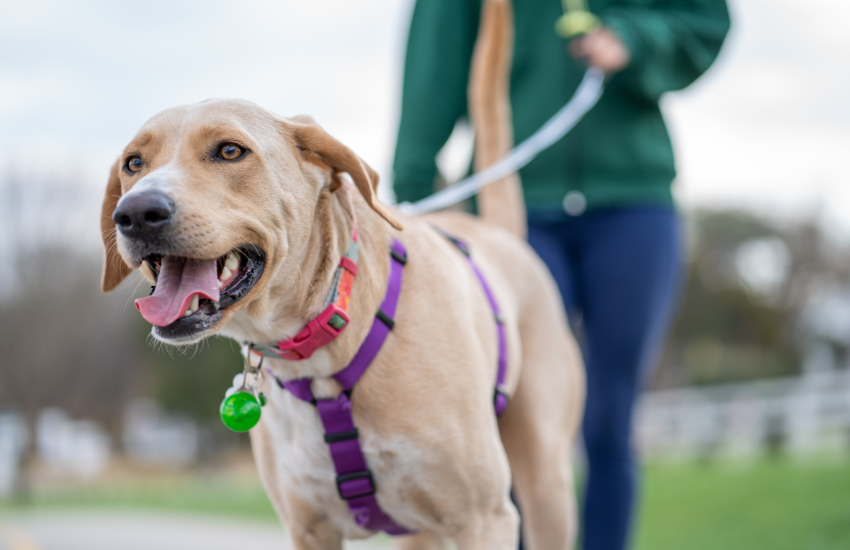

Leash Training for Reactive Dogs: Techniques for Managing Reactive Behavior
Walking your dog should be a pleasant and stress-free experience, but it can be a challenging and anxiety-inducing ordeal for many owners of reactive dogs. Reactive behavior in dogs is a common issue, and it often manifests as barking, lunging, or pulling when encountering other dogs, people, or various stimuli during walks. The good news is that with the proper techniques and guidance, you can effectively manage and reduce reactive behavior, allowing you and your dog to enjoy peaceful and enjoyable walks together.
In this blog, let’s delve into various aspects of leash training for reactive dogs and troubleshooting common challenges. We’ll equip you with the knowledge and techniques to transform your walks into enjoyable experiences for you and your furry companion.
Puppy training: The foundation of dog leash training

Dog leash training should ideally begin when your dog is a puppy. This early introduction helps them establish good habits from the start. Here are some essential tips for leash training a puppy.
#1 Start slowly:
Begin with short, positive leash sessions in a quiet environment. Use treats and praise to reward your puppy for walking beside you without pulling.
#2 Use a proper leash and collar:
Choose a comfortable, well-fitting collar or harness and a lightweight leash for your puppy. Avoid using choke chains or prong collars, as they can be harsh on a young dog.
#3 Positive reinforcement:
Reward your puppy with treats and praise for walking politely on the leash. This positive association with the leash will make them more eager to cooperate.
#4 Practice loose leash walking:
Encourage your puppy to walk with a loose leash. If your dog pulls, stop walking and only continue when the leash slackens. This teaches your dog that pulling doesn't get them where they want to go.
Loose leash walking
Loose leash walking is the ultimate goal of leash training. You can easily achieve it by;
Practice in low-stress environments
Begin training in quiet, less stimulating areas before gradually progressing to busier environments.
Be patient
Dog leash training takes time, so be patient with your dog. Avoid punishing or yanking on the leash, creating stress and fear.
Reactivity: Understanding and managing it
Reactive behavior can be challenging, but understanding its underlying causes is crucial. Common triggers for reactivity include fear, anxiety, territoriality, or past negative experiences.
Here are some techniques for managing reactive dogs.
#1 Desensitization and counterconditioning
Gradually expose your dog to their triggers at a distance where they don't react negatively. Reward them with treats when they remain calm, creating a positive association with the trigger.
#2 Focus and engagement
Teach your dog to focus on you during walks. Practice commands like "watch me" to redirect their attention from potential triggers.
#3 Distance control
Maintain a safe distance from triggers. If your dog reacts, increase the distance until they're comfortable.
#4 Professional help
If reactivity is severe, consult a professional dog trainer or behaviorist. They can provide specialized training and guidance.
Breed considerations: Understanding your dog's nature
Different dog breeds have varying tendencies and energy levels, which can influence their behavior on the leash. Here are some breed-specific considerations.
Herding breeds
Herding breeds like Border Collies and Australian Shepherds may have a strong instinct to chase or control movement. Proper training and mental stimulation are essential.
Hound breeds
Hound breeds like Beagles and Bloodhounds often follow their noses, so a strong recall is vital when walking them off-leash.
Working breeds
Working breeds like German Shepherds and Siberian Huskies need physical and mental exercise. A well-exercised dog is more likely to walk calmly on the leash.
Small Breeds
Small breeds can be more prone to leash reactivity due to their size. Use a properly fitting harness to reduce strain on their neck.
Troubleshooting common challenges
Challenges may arise during leash walks, even with the best training. Here are some common issues and their solutions.
Pulling
If your dog pulls on the leash, stop walking until they return to your side. Then, continue walking.
Overexcitement
Teach your dog to stay calm by practicing calm sits and down-stays during walks.
Lunging
If your dog lunges at other dogs or people, consider using a head collar or no-pull harness for better control.
Happy training!

Managing reactive dogs can be difficult, but with effective leash training and management techniques, you can help your dog feel more calm and secure while on walks.
From the foundation to understanding various considerations, your reactive dog can become well-behaved and happy with proper training and management. Ultimately, the most important thing you can do as a pet owner is to be patient and compassionate while working with your furry friend.

